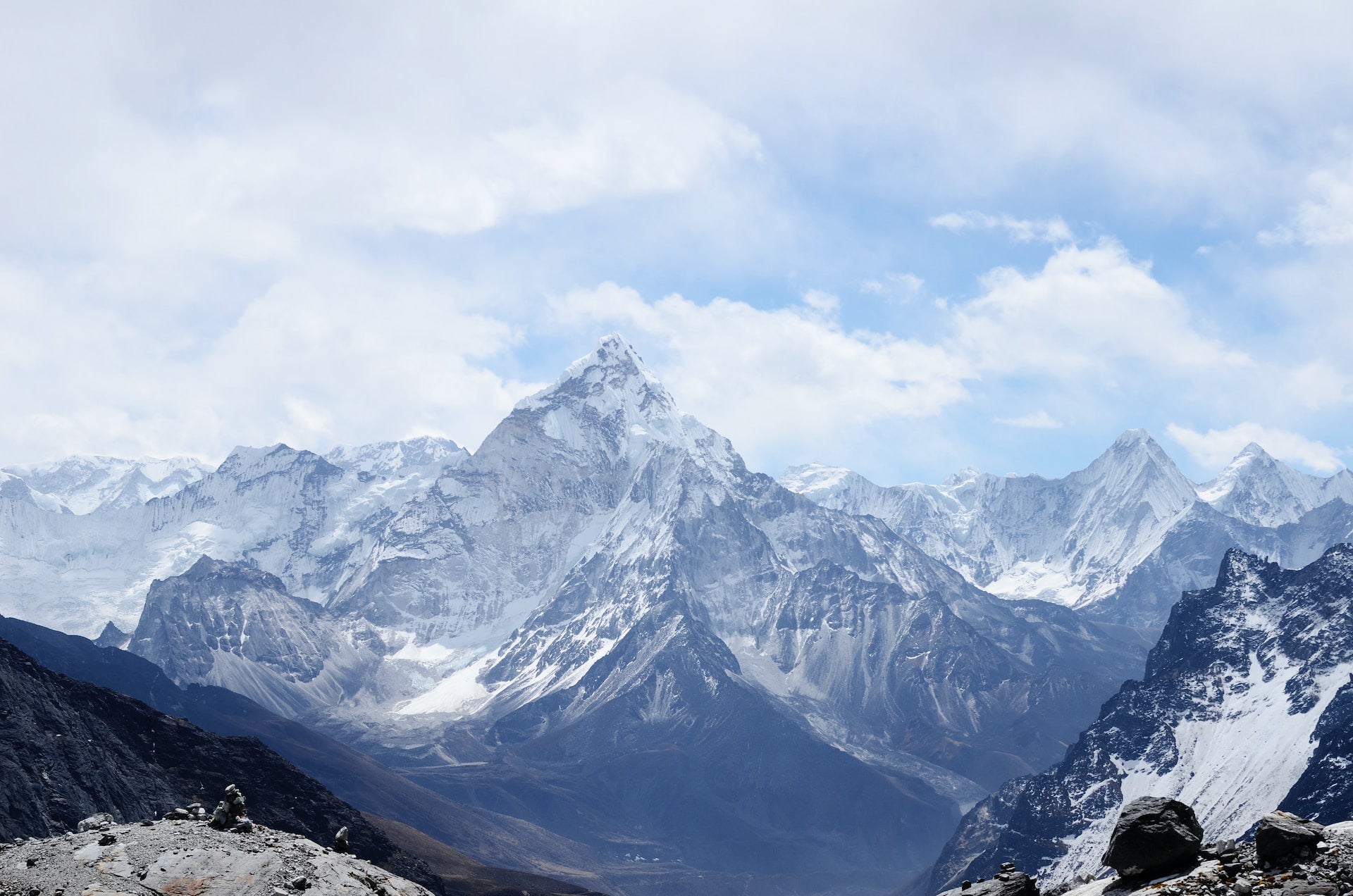Recently released books from Nims Purja and Jimmy Chin are not only must-reads for mountaineers and climbers, but also contain valuable pearls of wisdom for anyone pursuing excellence in everyday life. In this post, we'll share some of these gold nuggets from Nims and Jimmy, as well as a wise teaching from Kit DesLauriers, who scaled and skied down the Seven Summits.
- Commit to a Quest
Despite there being some undeniably badass female alpinists – such as Gerlinde Kaltenbrunner, Lynn Hill, and Melissa Arnot Reid – mountain climbing is still predominantly a male-dominated world. So when Kit DesLauriersdecided to take on the Seven Summits (scaling the highest peak on each continent), she not only had to push her own physical limits and find the right support team to put her on top of the world, but also needed to confront significant chauvinism.
Fortunately, Kit never does anything half-heartedly, as demonstrated by her winning back-to-back World Freeskiing Tour titles. So when she took on the challenge of getting to the top of these seven gigantic mountains, it was with an added twist – skiing down afterward. In October 2006, Kit completed the final summit on the highest one of all: Mount Everest. The feat earned her a National Geographic Explorer of the Year award and made her the first person to complete the monumental climb up-ski down challenge. In an interview with all-natural, wild-harvested supplement company HANAH, Kit explained what she’d learned from heading out on such an ambitious project:
“When you have a quest, it puts you in the middle of what you say you want to do. It gives you a focus and a purpose. When I first started the Seven Summits, I was still on the World Freeskiing Tour and knew that if anything went wrong in a competition it would jeopardize the Summits. That taught me to step back from the long-range goal that was driving me and be completely present in the moment. I became detached from the outcome.
You can’t go looking for a defining epiphany if you’re not embodying the moment and waiting for that opportunity to present itself. When I’m skiing, my field of vision is constantly adjusting. I’m looking a thousand feet down the mountain but also at the next four or five turns. Yes, we need to keep our eyes on the goal that we’re striving for but also balance that with awareness of what’s right in front of us. And then give ourselves the space to go back and forth between the two.”
The takeaways? Set an ambitious target and then commit fully to it. Learn to delight in the process of advancing toward your goal and stay fully present as you keep the big picture in mind.
- Stare Down Defeat
Nirmal “Nims” Purja grew up among the high peaks of Nepal, which he refers to as “home of the 8,000ers” – i.e., mountains that are at least 8,000 meters high. Consider the fact that the country has more of these than any other (eight), and perhaps it’s unsurprising that Nims would one day make his name as an alpinist. But first he was determined to follow his father and brothers by serving in the Gurkhas, the British Army regiment staffed by hardy Nepalese soldiers. He achieved this aim and then made it through the grueling selection process for the Special Boat Service, the special forces unit of the Royal Navy, becoming the first Gurkha to do so.
While bravely serving for 16 years, Nims developed a passion for mountaineering that saw him lead his SBS unit to Everest base camp, rescuing a stricken climber along the way. The following year, a guide led him up the 6119-meter Lobuche East, giving Nims the skills and confidence to take a Gurkha team to the top of the lesser-climbed but daunting 8000er Dhaulagiri. He then led another expedition in a successful Everest summit bid. On his next trip to the world’s tallest peak, Nims not only climbed it, but also the neighboring Lhotse and Makalu, setting a world record for the trifecta of just five days.
Completing these climbs gave Nims the confidence to embark on a new challenge. Retiring from active duty, he set his sights on climbing all 14 of the world’s 8000-meter peaks. The record for this grueling feat of physicality and logistics was just under eight years, but Nims believed that he could accomplish it in seven months. Many doubters scoffed at this relatively inexperienced mountaineer and told him it was impossible, so he inverted their doubt and launched Project Possible. On October 29, Nims stood atop Shishapangma with his all-Sherpa team, having completed his mission in just six months and six days. But despite his triumph – recorded in the Netflix film 14 Peaks – Nims revealed in his book Beyond Possible that he had to confront defeat throughout the expedition:
“My biggest concern through the mission was not finishing, either through weakness or dying, so I used the potential consequences of failure as a way of not quitting. I pictured the disappointed people who had once looked to my project for inspiration, or the doubting jokers that would inevitably make comments in interviews and call me out online. Their faces fired me up…at my lowest ebbs, such as in the middle of a day-long trailblaze, I forgot about the aching muscles in my legs and back simply by imagining the burn of humiliation. I was soon able to make another step through the heavy snow, or along the rope, until one step became two, two steps became ten, ten steps became a hundred.”
So when you’re feeling like you can’t continue in challenging circumstances, picture Nims and his team pushing up a sheer mountainside, the wind and snow blowing in their faces. Consider how you’ll feel if you fall short in your own project, then resolve to keep inching onward.
- Know When to Quit, Then Try Again
Jimmy Chin is perhaps best known in the mainstream for the Academy Award that he and his wife, Elizabeth Chai Vasarhelyi, won for chronicling Alex Honnold’s historic climb of Yoesmite’s El Capitan in their documentary Free Solo. Yet as famous as he has now become for filmmaking, Jimmy has spent over 20 years taking still shots in far-flung locations across the globe, regularly contributing to renowned magazines and newspapers and winning the National Geographic Photographer’s Photographer Award from his peers in 2020. Along the way, he has also become an elite climber, skier, and mountain athlete who combines rare athleticism with an uncanny eye for the perfect picture.
There and Back is Jimmy’s first photography book. In it, he showcases stills from shoots in Mali, Oman, Patagonia, Antarctica, and more. Though there is some highlight-reel fodder of his own expeditions and capturing the likes of Tommy Caldwell and Kevin Jorgeson as they scaled the Dawn Wall and Honnold completing the Free Rider route, the book’s real pearls of wisdom are found in the struggles Chin recounts. And nothing in his career was quite as gnarly as Meru.
Also known as the Shark’s Fin for its distinctive shape, the central summit of Meru Peak rises 20,702 feet above sea level in India’s Gawhal Himalaya. At least 20 expeditions had tried to climb this intimidating granite blade by the time Jimmy showed up there with veteran climbers Conrad Anker and fellow photographer/filmmaker Renan Ozturk in 2008. Among them was Conrad’s mentor, the legendary Terry “Mugs” Stump, who died from falling into a crevasse while descending the South Buttress of Denali in May 1992.
“After a few more days of climbing and several heroic leads by Conrad on poorly protected mixed terrain, we had finally arrived at our limits on the seventeenth day,” Chin wrote in There and Back. “We hung in our harnesses two hundred feet from the summit. To continue would require a night out in the open and frostbite or worse. When you seek the edge, sometimes you find it. Numb and defeated, we prepared for the long descent into the night. I stole one last look at the summit above, and vowed to never come back.”
The trio was not only out of daylight, but also critically low on food and water. Jimmy’s feet were so messed up that he was in a wheelchair for a couple of weeks after returning home. But as mentally and physically debilitated as they felt in the moment, it wasn’t long before Conrad was planning a return to Meru. Though Jimmy was swept away by an avalanche and Renan seriously injured in a skiing accident, the two insisted on joining their friend in another summit bid, which Jimmy and Chai later documented in their award-winning documentary, Meru.
“We knew the next try wouldn’t happen immediately. We needed some time to forget the pain, the suffering, and the defeat. Three years proved enough, and we were ready to take another shot at the Shark’s Fin,” Jimmy wrote. “Despite our dress rehearsal in 2008, the climbing on the upper Fin didn’t seem any less desperate. But after twelve days of ascent we arrived on the most improbably summit of our lives. ‘I got it for you, Mugs,’ Conrad declared when we topped out, his voice thick with emotion. He’d settled a piece of unfinished business for his departed friend and mentor, Mugs Stump. The three of us had done the same for each other.”
Jimmy, Conrad, and Renan’s Meru odyssey shows the value in putting together a complementary team that’s willing to go to the limit for each other. It’s also a potent reminder that sometimes you need to turn back when you’re just short of your goal, which will actually set you up for success on your next attempt.



















